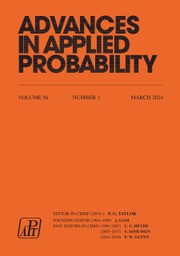Crossref Citations
This article has been cited by the following publications. This list is generated based on data provided by
Crossref.
Dupuis, Paul
and
Wang, Hui
2002.
Optimal stopping with random intervention times.
Advances in Applied Probability,
Vol. 34,
Issue. 1,
p.
141.
Pham, Huyên
and
Tankov, Peter
2008.
A MODEL OF OPTIMAL CONSUMPTION UNDER LIQUIDITY RISK WITH RANDOM TRADING TIMES.
Mathematical Finance,
Vol. 18,
Issue. 4,
p.
613.
Pham, Huyên
and
Tankov, Peter
2009.
A Coupled System of Integrodifferential Equations Arising in Liquidity Risk Model.
Applied Mathematics and Optimization,
Vol. 59,
Issue. 2,
p.
147.
Liu, XiaoPeng
and
Liu, KunHui
2009.
The generalization of a class of impulse stochastic control models of a geometric Brownian motion.
Science in China Series F: Information Sciences,
Vol. 52,
Issue. 6,
p.
983.
Tian, Shao Lin
Li, Ji Chun
and
Liu, Kun Hui
2012.
A Class of Stochastic Control Problem Governed by a Poisson Process.
Advanced Materials Research,
Vol. 450-451,
Issue. ,
p.
46.
Wei, Jiaqin
Wang, Rongming
and
Yang, Hailiang
2012.
On the Optimal Dividend Strategy in a Regime-Switching Diffusion Model.
Advances in Applied Probability,
Vol. 44,
Issue. 3,
p.
886.
Lempa, Jukka
2014.
Bounded Variation Control of Itô Diffusions with Exogenously Restricted Intervention Times.
Advances in Applied Probability,
Vol. 46,
Issue. 1,
p.
102.
Menaldi, J. L.
and
Robin, M.
2017.
On Some Impulse Control Problems with Constraint.
SIAM Journal on Control and Optimization,
Vol. 55,
Issue. 5,
p.
3204.
Menaldi, J. L.
and
Robin, M.
2018.
On Some Ergodic Impulse Control Problems with Constraint.
SIAM Journal on Control and Optimization,
Vol. 56,
Issue. 4,
p.
2690.
Menaldi, J. L.
and
Robin, M
2019.
Modeling, Stochastic Control, Optimization, and Applications.
Vol. 164,
Issue. ,
p.
427.
Yoshioka, Hidekazu
2020.
Two-species competing population dynamics with the population-dependent environmental capacities under random disturbance.
Theory in Biosciences,
Vol. 139,
Issue. 3,
p.
279.
Saarinen, Harto
and
Lempa, Jukka
2021.
Ergodic control of diffusions with random intervention times.
Journal of Applied Probability,
Vol. 58,
Issue. 1,
p.
1.
Palmowski, Zbigniew
Pérez, José Luis
and
Yamazaki, Kazutoshi
2021.
Double continuation regions for American options under Poisson exercise opportunities.
Mathematical Finance,
Vol. 31,
Issue. 2,
p.
722.
Yoshioka, Hidekazu
Tsujimura, Motoh
Hamagami, Kunihiko
Yaegashi, Yuta
and
Yoshioka, Yumi
2021.
HJB and Fokker-Planck equations for river environmental management based on stochastic impulse control with discrete and random observation.
Computers & Mathematics with Applications,
Vol. 96,
Issue. ,
p.
131.
Yoshioka, Hidekazu
2021.
Computational Management.
Vol. 18,
Issue. ,
p.
23.
Yoshioka, Hidekazu
and
Yaegashi, Yuta
2021.
Stochastic impulse control of nonsmooth dynamics with partial observation and execution delay: Application to an environmental restoration problem.
Optimal Control Applications and Methods,
Vol. 42,
Issue. 5,
p.
1226.
Yoshioka, Hidekazu
and
Tsujimura, Motoh
2022.
Hamilton–Jacobi–Bellman–Isaacs equation for rational inattention in the long-run management of river environments under uncertainty.
Computers & Mathematics with Applications,
Vol. 112,
Issue. ,
p.
23.
Yoshioka, Hidekazu
and
Tsujimura, Motoh
2022.
Optimal sizing of the sediment replenishment capacity based on robust ergodic control of subordinator-driven dynamics.
Optimization,
Vol. 71,
Issue. 11,
p.
3383.
Yoshioka, Hidekazu
and
Yoshioka, Yumi
2022.
Designing cost-efficient inspection schemes for stochastic streamflow environment using an effective Hamiltonian approach.
Optimization and Engineering,
Vol. 23,
Issue. 3,
p.
1375.
Yoshioka, Hidekazu
and
Yaegashi, Yuta
2022.
Optimally controlling a non-smooth environmental system with random observation and execution delay.
Vol. 2425,
Issue. ,
p.
110002.

